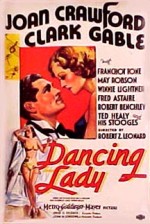Millionaire Tod Newton takes his friends on a slumming trip to a burlesque show and finds himself attracted to Janie Barlow, one of the strippers. When the place is raided, Tod bails the broke Janie out, but she accepts the money only as a loan. That same night, Tod also send her fifty dollars to buy herself a dress "without a zipper." She decides to move uptown and try out for a new show directed by Patch Gallagher, but when she can't get past the doorman, and even following Patch everywhere won't help, Tod again comes to her rescue by secretly arranging to back the show on condition that Patch hire Janie for the chorus. Patch doesn't want anything to do with a rich man's girl friend, but when he sees how well Janie dances, he places her in the front row. Soon Tod proposes and Janie accepts, but only if the show fails. Meanwhile, Patch has realized that neither his show nor his star, Vivian Warner, is right, so he gives Janie the lead of the new version. Although Patch and Janie are attracted to each other, Janie decides to go away with Tod when he secretly withdraws his backing and rehearsals stop. While they are away, Patch uses his own money for the show. When Janie returns and discovers Tod's deception, she begs Patch to take her back. On opening night, Janie is a big hit in her numbers with Fred Astaire and Nelson Eddy, and Tod realizes that Broadway, not Park Avenue should be Janie's address. Patch and Janie also realize that they are more than star and director.
Speaking of teams, Dancing Lady was the fourth of seven films costarring Clark Gable and Joan Crawford. Gable was not yet a super-star. That would come with his next film when he was lent to Columbia for It Happened One Night. Here he still takes second billing (as he would continue to do) to MGM stalwart Crawford. After her early silent flapper image, Crawford had gone dramatic; Dancing Lady represented a change of pace for her.
MGM was still trying to do backstage musicals, hoping to capture some of the glory (and box office receipts) from Warner Bros. Both Nelson and Fred Astaire (in his film debut) have musical numbers, but are more or less wasted.
The theme that Nelson had somehow sold out and prostituted his art was beginning. A review in the Philadelphia Inquirer noted: "Nelson Eddy, Philadelphia baritone, who made good in opera and concert, and turned a willing ear to Hollywood's siren song, is to be seen and heard in one musical number as a typical revue singer."
Glossy backstage romance is best remembered for Astaire's film debut (he plays himself), dancing opposite a less-than-inspired Crawford. Show-biz story, three-cornered romance are strictly standard, but cast and MGM gloss add points. Funniest moments belong to the Three Stooges. Look fast for a young Eve Arden.
Aucun dossier informatif complémentaire concernant Dancing Lady
Aucun dossier informatif complémentaire concernant Dancing Lady
Pas encore de video disponible pour ce spectacle
